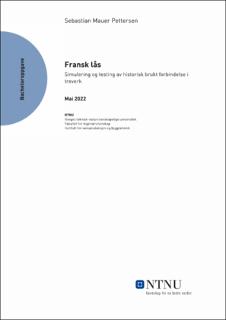| dc.contributor.advisor | Landgraff, Marthin | |
| dc.contributor.author | Pettersen, Sebastian Mauer | |
| dc.date.accessioned | 2022-08-31T17:19:59Z | |
| dc.date.available | 2022-08-31T17:19:59Z | |
| dc.date.issued | 2022 | |
| dc.identifier | no.ntnu:inspera:106258180:112687827 | |
| dc.identifier.uri | https://hdl.handle.net/11250/3014799 | |
| dc.description.abstract | Klimaendringer og overforbruk av ressurser er reelle utfordringer vi står overfor i dag. Det er nødvendig med store samfunnsendringer for å møte disse. Innen byggenæringen har ombruk av byggematerialer vokst frem som et stadig mer aktuelt tema som bidrar til dette. Fremstilling av stål er energikrevende, og dermed en belastning på miljø. Reduksjon av stål i bygningskomponenter vil derfor være ønskelig.
Denne rapporten har som hensikt å bidra til økt ombruk og reduksjon av stål i byggenæringen ved å se på den historisk brukte forbindelsen «Fransk lås» og undersøke hvilken utforming av denne som har størst kapasitet ved aksielt strekk.
Dette har vært gjort ved simuleringer, håndberegninger og fysisk testing på lab. Som en kontroll av at utforming av forbindelse skulle være utslagsgivende faktor ble det av den ene variasjonen testet med et annet materiale. Snittverdier av kontrolltesting viste et avvik på 0,008%, som tyder på at utforming vil være utslagsgivende faktor.
Med bakgrunn i teori og samlet empirisk data kom man frem til et resultat. Sammenligning av resultatene viser at det vil kreve mer forskning for å kunne konkludere med kapasitet til forbindelsen. Simuleringer, håndberegninger og testing på lab viser alle sammen at utformingen «Lang Skrå» har høyest kapasitet. | |
| dc.description.abstract | Climate change and over-consumption of resources are real challenges we face today. Major societal changes are needed to meet these. In the construction industry, the reuse of building materials has emerged as an increasingly relevant topic that contributes to this. The production of steel is energy-intensive, and thus a burden on the environment. Reduction of steel in building components will therefore be desirable.
The purpose behind this report is to contribute to an increase in reuse of building materials by researching the historically used timber joint type, scarf joint with tenon and key, to see what configuration of this connection that had the highest capacity in axial tension.
This has been done by performing simulations, hand calculations and physical tests in a lab. As a control to ensure that configuration would be the deciding factor, one of the configurations was tested in a different material. The average values of the control showed a deviation of 0,008%, which can indicate that configuration is the deciding factor.
Based on theory and gathered empirical data, a result was reached. Comparing the results shows that more research is needed to conclude on a load capacity of the joint. Simulations, hand calculations and lab tests all show that the configuration “Lang Skrå” (Long inclined) has the highest capacity in axial tension. | |
| dc.language | nob | |
| dc.publisher | NTNU | |
| dc.title | Fransk lås
Simulering og testing av historisk brukt forbindelse i treverk | |
| dc.type | Bachelor thesis | |
